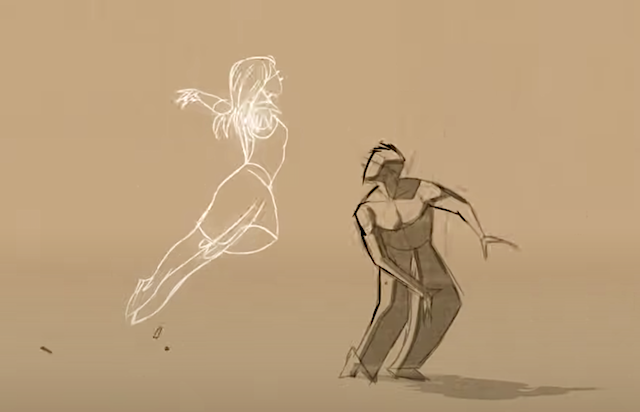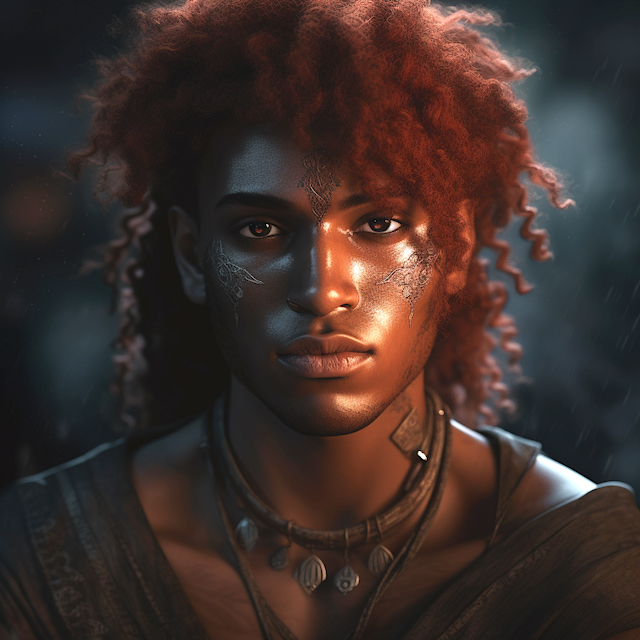
screen cap from Ryan Woodward’s award-winning short animation Thought of You
About 20 years ago, when I was speaking at an event in the UK, I was asked to pick three adjectives to uniquely* describe myself. After thinking about it, one of the words I chose was hedonistic. It’s been part of my bio ever since.
Everything I’ve learned seems to confirm that all animals are driven by the desire to maximize pleasure and minimize pain. When I attempted to identify my Ikigai last year (the things that get me up in the morning and give direction to my life), I realized that almost all of them were hedonistic. And a lot of them were about the enjoyment of beauty in all its facets — in music, creative works and the arts, beautiful places, wild creatures and people, beautiful ideas and discoveries, beautiful games and puzzles and designs and models.
When I started playing with the Midjourney AI image creator, I wondered: What is the most popular subject, and the most popular adjective, in users’ image prompts? It took very little time to discover that the most popular subjects were fantasy and women, but one adjective appeared in twice as many prompts as either: the word beautiful.
I wrote about the subject many years ago, but in some recent email exchanges about why people want to see images of beautiful things, I was asked: What is it that makes something beautiful?
I thought about that, and then of course I asked ChatGPT. Its answer was quite good (I’ve shortened and paraphrased it a bit):
- Symmetry, harmony and proportion
- Complexity, mystery, variety, and intricacy
- Resonance with the natural world, both its familiarity and sense of belonging, and its strangeness and diversity, the sense of wonder it arouses in us
- Elegance and simplicity
- Emotional impact, a capacity to touch or move both the heart and the mind
- Cultural familiarity and synergy (our aesthetic preferences are culturally conditioned)
- Associations and memory (we find ‘reminders’ of things we love or loved, to be beautiful)
- Uniqueness, novelty, and the element of surprise and unexpectedness
- Skilfulness, craftsmanship and perfection (we find beauty in excellence of process or product)
I remember when I was studying art and composition many years ago (a course I audited), being told that there are two types of beauty: natural beauty and artistic beauty. The former, I was told, can be and is appreciated by all creatures, and is a biological, inherited appreciation, while the latter, apparently, is only appreciated by humans, and it is a culturally learned appreciation.
There is a reasonable argument to be made that our love of natural beauty is co-evolutionary: that the environment to which we were best suited co-evolved with us and other creatures, and hence our attraction to its beauty is both a cause and a result of our living in places we consider beautiful. There is a similar argument that our artistic tastes are conditioned by what we are exposed to throughout our lives, how our patterning, judging, sense-making brain evolves, since different cultures have remarkably different senses of what is beautiful.
TS Eliot made the argument that great poetry must appeal to us (ie give us pleasure) both intellectually (through offering a new idea or way of thinking or seeing) and emotionally (“moving” us in some way, through imagery, pathos etc). Perhaps that’s true of all great art. Creating a beautiful work of art then becomes a bit of a balancing act — it has to be culturally accessible to us but not to the point of being clichéd; it has to challenge us a bit intellectually and emotionally.

Many of the studies of what people find beautiful are based on being shown human faces and gauging our reactions, perceptions and judgements about them. We’re told that we find symmetrical, harmonious, well-proportioned faces beautiful (criterion #1 on the list above), but also appreciate a degree of complexity, mystery, or uniqueness in facial features (criteria #2 and #8 above). And that as we get older, cultural familiarity and memory association (criteria #6 and #7) weigh in more strongly.
The face pictured above, Midjourney’s depiction of a “very beautiful Black man” is certainly symmetrical, and perfectly proportioned according to the supposed ideal/average facial proportions that aestheticians attempt to recreate.
I was going to post my favourite painting to conclude this article, but I’m not sure which it would be. Pam O’Connell’s In Deep Conversation would be in the running. So would Sławek Gruca’s Family Portrait. For drawings it would probably be any of Rebecca Clark’s Diptychs. For mixed media it might be Ron Woodall’s Snug Cove Dogs. In sculptures, Marisol Escobar’s series of Magritte carvings would be up there. Perhaps favourite photo would be Maren Yumi Motomura’s Brazilian Buddhist retreat photo I call Mindful Wandering.
They all hit different ‘buttons’ from the above list of nine criteria for beauty.
If you had to choose only one painting or other work of art to have in your home, what would you choose? (You don’t have to limit your choices to works you could afford.) And if you can narrow it down, what is the ‘main’ reason you find that piece so exceptional?
* This was a fascinating exercise, and one that taught me something about myself. The exact challenge was: Pick three adjectives that you think uniquely describe you, words that you doubt many people would ever use to describe themselves.





The universe, the great mystery, is love. And you can’t understand it, you just have to feel it. So it makes sense that evolution is love and that is the magical, powerful force that drives humans.
I have many times been in a situation (like a Transition Towns group thinking about the next step) where instead of asking “what does Rob Hopkins manual say?” people started exploring what their flow was telling them.
So love – or what ever word you choose to give “that” – is the force of survival, of sustainability, of human development.
It gives rise to a wonderful human experience of being in that feeling. It’s like gardening. Gardening is so wonderfully humbling, as you put the little of what you know, have heard, have as a inkling etc into practice and the results are whatever they are. You see the beauty in the weeds that turn up, the insects. The more you learn the more humble you get about what you know, the more you wonder at nature’s power, and the more you want to be driven by love of life rather than instructions in a gardening book and life’s “musts”. Although, of course, you read the books avidly and write to-do lists!
Beauty is essential to permaculture. It is a signal that all is well and we can relax and enjoy, our garden is giving.
Today, my choice would be Mary Pratt’s “Jelly Shelf”
https://www.gallery.ca/sites/default/files/import/jelly-shelf_1.jpg
because of the light, and memories, and the elevation of the ordinary, and the skill
I just feel happy when I look at it
Second would be Carol Evans, “Bathing in Light”
https://www.carolevans.com/small-prints/bathing-4plwr
again because of the light (I’m seeing a trend), childhood, play, joy, family and the skill of the painter
And I’ll keep feeling into what those three adjectives might be…
Thanks Iyeshka. One of my favourite paintings, by Terry Kolber, is also very much about the magic of light: https://howtosavetheworld.ca/images/car-in-rainstorm.png
Curious challenge to identify beauty and nominate examples. I’m more inclined toward music than painting or photography, which arguably exists in time rather than space, but I’ll offer a few suggestions (sorry, no links). Enigmatic, trompe-l’œil images such as the Mona Lisa and Escher drawings fascinate. My favorite along those lines is Andrew Wyeth’s Christina’s World. In terms of stylized and intricate, I like Gustav Klimt and Egon Scheile (pick any number of examples). For paintings that vibrate with unexpected resonance and intensity, see Mark Rothko.
See Ode to a Grecian Urn by John Keats. The poet is looking at an ancient urn in a museum or such place. It is engraved with the scene as described in the poem. I read it as a teenager and it has stayed with me ever since.
So, Theresa, would you agree that “beauty is truth, and truth beauty”?
Oh absolutely. I just didn’t want to leave a long winded comment. Although I’ve known that for decades, I just today started thinking what the opposite of beauty might be,
and what would be a good example. The word “ugly” doesn’t mean much to me. Been thinking about the ideas of revulsion/disgust but those mostly stand in opposition to what we feel compelled by, not what we recognize as beautiful. The opposite would be something that I’ve seen you describe as “performative”. That word comes close. Still thinking on it.
If beautiful means ‘pleasurable to the senses’ (including perhaps our aesthetic sense) then perhaps the opposite of beautiful is painful, atrocious (etym.: fierce and cruel), artificial, or simply unattractive.